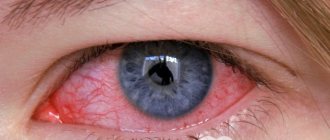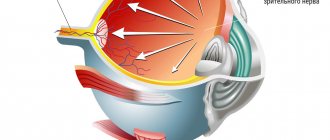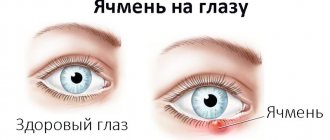Amaurosis is an ophthalmological disease characterized by loss of visual acuity. There are two types of this pathology: hereditary and transient. To date, the congenital form of the disease cannot be treated, however, transient amaurosis can be successfully treated with timely consultation with a specialist.
The term is derived from the Greek mauros - “dark” and means blindness that occurs without any objective pathological changes in the eyes. Currently, amaurosis has not been sufficiently studied, unlike other eye diseases. This term refers to any processes of rapid deterioration of vision and loss of vision for no apparent reason.
There are two main forms of the disease:
- hereditary or congenital - Leber amaurosis;
- transitory, or transient.
Transient amaurosis
A transient form, also called transient, can occur with some ongoing diseases. The most common cause of amaurosis is disorders or injuries in the neck and head:
- neoplasms that impede blood circulation;
- narrowing or constriction of blood vessels;
- aneurysms, atherosclerotic changes in blood vessels, their embolism (blockage).
The onset of transient amaurosis may be preceded by a stroke, heart attack, or ischemic attack. It is after these conditions that the patient has complaints about impaired sensitivity in the legs or arms, a tingling sensation in them.
Paresis of the facial muscles may also occur - difficulty speaking, swallowing food, nausea, headache, dark spots before the eyes.
Most often, amaurosis occurs on one side, while visual acuity in the affected eye decreases - the image becomes blurred. Ophthalmoscopy may reveal retinal infarction, leading to optic nerve atrophy.
Other causes of transient amaurosis may be previous eye or head injuries, intoxication with alcohol, narcotic or toxic substances. In all these cases, there is a dysfunction of the mechanisms responsible for transmitting visual images to the brain.
Additional facts
Leber congenital amaurosis is a heterogeneous group of diseases caused by mutations in 18 genes encoding various retinal proteins, including opsin. Amaurosis was first described in the 19th century (in 1867) by T. Leber, who indicated the main manifestations of this disease - pendulum nystagmus, blindness, the appearance of pigment spots and inclusions in the fundus. The average prevalence of the disease is 3:100,000 population. The main mechanism of inheritance of the disease is autosomal recessive, but there are also forms that are transmitted according to an autosomal dominant principle. Leber's amaurosis affects both men and women equally. The disease accounts for approximately 5% of all hereditary retinopathy. Modern genetics is developing methods for treating this pathology; there are encouraging results of gene therapy for one of the forms of Leber amaurosis, caused by a mutation in the RPE65 gene. Separately, Leber optic nerve atrophy is distinguished, which is also characterized by a gradual loss of visual acuity and subsequently complete blindness. However, this disease is of a completely different genetic nature and is caused by damage to mitochondrial DNA, which has its own unique type of inheritance (maternal).
Leber's amaurosis
Types of transient amaurosis
From many years of medical practice, it has been revealed that this form of the disease occurs most often in certain diseases.
- Monocular blindness
Temporary blindness occurs periodically in one eye and can last from 3-5 seconds to 5 minutes. If such symptoms recur constantly, this indicates disorders in the system of the carotid and ophthalmic arteries (spasm, thrombosis, embolism), which cause retinal ischemia. Such temporary blindness always occurs unexpectedly. Sometimes, according to patients, surrounding objects change color and become yellowish or greenish. Then the restoration of vision occurs as quickly as its temporary loss.
The problem is solved with the help of endarterectomy, which increases the patency of the carotid arteries.
It is considered one of the most effective operations in modern vascular surgery.
- Anterior ischemic oculopathy
With this disease, changes occur in the anterior segment of the eye, which can be manifested by swelling of the sclera, mydriasis of the pupil and its sluggish reaction to light, and sometimes its complete absence, pathological growth of blood vessels in the iris, a decrease or increase in intraocular pressure. When examining the visual organs, stagnation of blood in the veins of the retina, hemorrhage into it, and dilation of the arteries are diagnosed.
- Photosensitive retinopathy
This form of amaurosis occurs under the influence of bright light, which causes a slowdown in the metabolic process in the retina, and this, in turn, helps to reduce the resynthesis of rhodopsin, the main visual pigment.
Causes
The main mechanism of visual impairment in Leber amaurosis is a metabolic disorder in rods and cones, which leads to lethal damage to photoreceptors and their destruction. However, the immediate cause of such changes varies depending on which gene mutation caused the disease. One of the most common types of Leber amaurosis (type 2, LCA2) is caused by the presence of a mutant RPE65 gene on the first chromosome. More than 80 mutations of this gene are known, some of which, in addition to Leber amaurosis, also cause certain forms of retinal pigmentary abiotrophy. The protein encoded by PRE65 is responsible for the metabolism of retinol in the pigment epithelium of the retina, therefore, in the presence of a genetic defect, this process is disrupted with the development of side metabolic pathways. As a result, the synthesis of rhodopsin in photoreceptors stops, which leads to the characteristic clinical picture of the disease. Mutant forms of the gene are inherited according to an autosomal recessive mechanism. A less common form of Leber amaurosis (type 14) is caused by a mutation in the LRAT gene on chromosome 4. It encodes the lecithin retinol acyltransferase protein, which is located in the microsomes of hepatocytes and is found in the retina. This enzyme is involved in the metabolism of retinoids and vitamin A; due to the presence of mutations in the gene, the resulting protein cannot fully perform its functions, which is why photoreceptor degeneration develops, which is clinically manifested by Leber amaurosis or juvenile retinal pigment abiotrophy. It has an autosomal recessive inheritance pattern. Leber amaurosis type 8 most often leads to congenital blindness; the CRB1 gene responsible for the development of this form of the disease is located on chromosome 1 and has an autosomal recessive inheritance pattern. It was found that the protein encoded by this gene is directly involved in the embryonic development of photoreceptors and retinal pigment epithelium. More accurate data on the pathogenesis of this form of Leber amaurosis have not been accumulated to date. The situation is similar with the mutation of the LCA5 gene, located on chromosome 6 and associated with type 5 amaurosis. Currently, the only protein encoded by this gene, lebercillin, has been identified, but its functions in the retina are unclear. Two forms of Leber amaurosis have also been identified, which are inherited by an autosomal dominant mechanism - type 7, caused by a mutation of the CRX gene, and type 11, associated with a violation of the IMPDH1 gene. The CRX gene encodes a protein that has many functions - controlling the development of photoreceptors in the embryonic period, maintaining their adequate level in adulthood, participating in the synthesis of other retinal proteins (it is a transcription factor). Therefore, depending on the nature of the CRX gene mutation, the clinical picture of Leber amaurosis type 7 can be varied - from congenital blindness to relatively late and sluggish visual impairment. Inosine 5′-monophosphate dehydrogenase 1, encoded by the IMPDH1 gene, is an enzyme that regulates cell growth and nucleic acid production, but it does not yet provide insight into the pathogenesis of how abnormalities in this protein lead to Leber amaurosis type 11.
Hereditary (congenital) Leber amaurosis
This type of disease is inherited in an autosomal recessive manner, that is, the defective gene is present in both parents, although they themselves do not suffer from amaurosis. Visual impairments appear during fetal development.
With Leber's congenital amaurosis, the production of rhodopsin, a visual pigment responsible for transmitting information from the eyes to the brain, is disrupted in the retina. Briefly, its action can be described as follows: rhodopsin is located in the rods of the retina and is responsible for transmitting nerve impulses to certain areas of the brain. It is thanks to rhodopsin that light entering the eyes causes stimulation in the optic nerve. The result of this complex combination is the ability of the eyes to see objects in different degrees of illumination.
It should be noted that the supply of rhodopsin in the retina is limited, so there is also a reverse process - resynthesis of rhodopsin, restoring its amount to the required level. On average, it takes about half an hour to completely restore the required amount of pigment.
With hereditary amaurosis of both eyes, due to the presence of a mutant gene in the retina, the rods that contain rhodopsin begin to die, as a result of which blindness occurs with an unchanged optic nerve.
Forms of the disease
There are two types of amaurosis: transient and congenital .
Transient
A transient type , also called transient, is a temporary disorder that occurs due to external or internal predisposing factors .
This disease is treated with medication, but often visual functions are restored on their own.
Congenital (Leber amaurosis)
It is worse if congenital amaurosis (Leber amaurosis) is diagnosed, in which a dysfunction of the retina is detected , and they, in turn, develop in the womb and are a genetic factor.
Note! In this case, the production of the visual pigment rhodopsin, which is responsible for transmitting information from the eyes to the brain, is disrupted in the retina.
Clinical symptoms of Leber amaurosis
Signs of the disease appear at an early age. The child has no reaction to toys and objects that are brought closer to him, his gaze wanders, the reaction of the pupils to light is weak or absent, and nystagmus is also noted. Amaurosis is often accompanied by strabismus or keratoconus. The disease can progress at different rates, but even with its slow progression, blindness occurs by about 9-10 years. Modern medicine does not know a radical way to combat congenital amaurosis; vision cannot be restored in this case. Children may also develop concomitant pathologies: endocrine diseases, changes in the musculoskeletal and central nervous systems. The child walks awkwardly and clubbingly, bumping into various objects. Since young children are not yet able to describe their feelings, responsibility for their health lies entirely with their parents.
Symptoms
Symptoms of amaurosis are:
- sudden complete or partial loss of vision, which may be reversible or irreversible;
- with partial deterioration of vision, general weakness and a feeling of disorientation in space may occur;
- dizziness;
- loss of visual fields;
- nystagmus;
- inability to focus the gaze on specific objects.
Depending on the cause of the development of the disorder, additional specific signs may be observed .
If amaurosis develops against the background of endocrine diseases, pain in the eyes and swelling of the eye muscles may occur.
And in the case of intoxication amaurosis, the patient experiences not only visual interference and loss of visual fields, but also disorientation and confusion.
If cancer develops, the symptoms will be almost the same, but they can appear gradually as the tumor grows.
But at a certain size, compression of the ocular vessels can occur, and in such situations the development of symptoms can be abrupt, and the patient begins to experience regular headaches and nystagmus.
Remember! In young children with identified Leber amaurosis, attention is primarily drawn to clumsiness and the inability to adequately assess distances to objects, as a result of which children are often injured, fall or bump into various objects.
Since children under 3-4 years old cannot describe their condition and talk about disturbing symptoms, you should pay attention to whether the child has symptoms that indicate the development of amaurosis :
- a wandering gaze that does not linger on individual objects;
- involuntary twitching and movements of the eyeballs;
- absence or significant decrease in visual reflexes;
- the child may not notice objects located in close proximity.
With such signs, it is necessary to undergo examination and begin treatment as soon as possible. The sooner action is taken, the greater the likelihood that the disease can be eliminated without serious consequences.
Diagnosis of the disease
The initial examination includes a visual examination and anamnesis.
The doctor finds out whether the patient has a history of amaurosis in his family. For a complete diagnosis, special techniques are used:
- electroretinography to determine the bioelectrical activity of retinal neurons;
- electrooculography;
- assessment of visual potentials.
The first method shows the most accurate results. If vision deteriorates not because of amaurosis of the eyes, but for other reasons, and they may not even be of ophthalmological origin, then the electroretinography readings will be normal. In this case, an examination is carried out to identify the true causes.
Treatment
We can talk about successful therapy only when a temporary, transient type of illness occurs. Unfortunately, in the case of Leber amaurosis, medicine is powerless: it is a genetic mutation that cannot be eliminated by surgical or drug methods. A specialist can only prescribe medications that relieve some symptoms. Proper upbringing and adaptation will help a sick child cope with the problems caused by the disease.
Treatment methods for the transient form depend on the cause of the disease.
Thus, to normalize blood circulation, hypotonic and nootropic drugs are prescribed that stabilize the condition of large vessels and capillaries. In case of tumors affecting the functioning of the optic nerve, surgical operations are performed. If vision deterioration is caused by endocrine disorders, then a course of medications that lower blood sugar levels, as well as hormonal therapy, may be prescribed. In case of alcohol or drug intoxication, the body is cleansed to remove toxic substances. In a word, successful treatment of transient amaurosis of the eyes lies in eliminating the cause that provoked it.
Classification
Currently, the relationship between clinical manifestations and mutations of certain genes for 16 types of Leber amaurosis has been fully proven. There are also indications of the discovery of two more genes, damage to which leads to this disease, but so far additional research is being carried out in this regard. • Type 1 (LCA1, from English Leber's congenital amaurosis) – damaged GUCY2D gene on chromosome 17, autosomal recessive inheritance type.
• Type 2 (LCA2).
Damaged RPE65 gene on chromosome 1, autosomal recessive inheritance, there are first positive results on gene therapy for this form of Leber amaurosis.
• Type 3 (LCA3).
Damaged RDH12 gene on chromosome 14, autosomal recessive inheritance.
• Type 4 (LCA4).
Damaged AIPL1 gene on chromosome 17, autosomal recessive inheritance.
• Type 5 (LCA5).
Damaged LCA5 gene on chromosome 6, autosomal recessive inheritance.
• Type 6 (LCA6).
Damaged RPGRIP1 gene on chromosome 14, autosomal recessive inheritance.
• Type 7 (LCA7).
Damaged CRX gene on chromosome 19, autosomal dominant inheritance.
Characterized by a variable clinical picture. • Type 8 (LCA8).
Damaged CRB1 gene on chromosome 1, autosomal recessive inheritance.
Statistically more often than other types it leads to congenital blindness. • Type 9 (LCA9).
Damaged LCA9 gene on chromosome 1, autosomal recessive inheritance.
• Type 10 (LCA10).
Damaged CEP290 gene on chromosome 12, autosomal recessive inheritance.
• Type 11 (LCA11).
Damaged IMPDH1 gene on chromosome 7, autosomal dominant inheritance.
• Type 12 (LCA12).
Damaged RD3 gene on chromosome 1, autosomal recessive inheritance.
• Type 13 (LCA13).
Damaged RDH12 gene on chromosome 14, autosomal recessive inheritance.
• Type 14 (LCA14).
Damaged LRAT gene on chromosome 4, autosomal recessive inheritance.
• Type 15 (LCA15).
Damaged TULP1 gene on chromosome 6, autosomal recessive inheritance.
• Type 16 (LCA16).
Damaged KCNJ13 gene on chromosome 2, autosomal recessive inheritance. In addition, sometimes in the clinical classification, not only the name of the damaged gene is distinguished, but also the nature of the mutation, since this has a significant impact on the course of Leber amaurosis. Moreover, different types of mutations in the same gene can lead to completely different diseases - for example, some types of deletions in the CRX gene can lead not to amaurosis, but to rod-cone dystrophy. Some mutations in the RPE65, LRAT and CRB1 genes cause various forms of retinal pigmentary abiotrophy.
Prevention of acquired amaurosis and recommendations
To prevent illness, doctors advise following simple rules. You should eat foods that contain minerals and vitamins that are beneficial for eye health: A, C, selenium, zinc, etc. It is recommended to take dietary supplements several times a year to improve visual acuity. It is better to exclude too fatty, spicy, smoked, salty foods from your diet - this will be beneficial for the whole body.
To improve blood circulation in the eyes, you need to perform special gymnastics - a set of exercises will be recommended by your doctor.
This is especially important when working hard at the computer or with papers. Moderate physical activity is also beneficial, as it stimulates the general blood circulation system.









